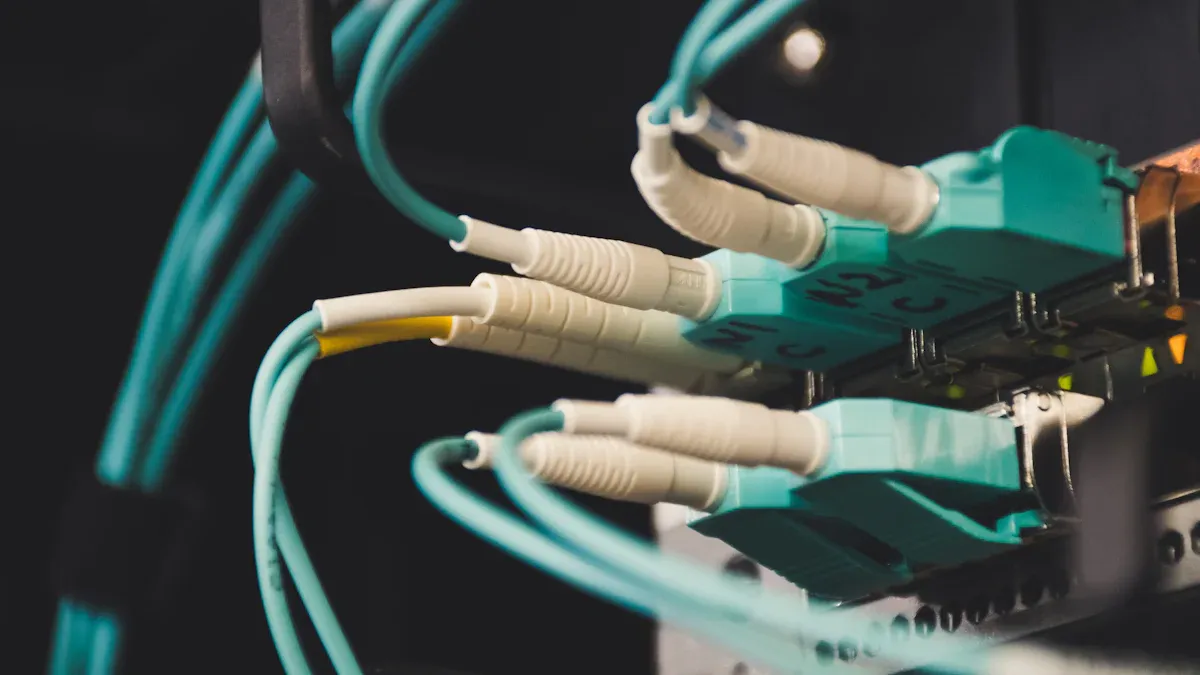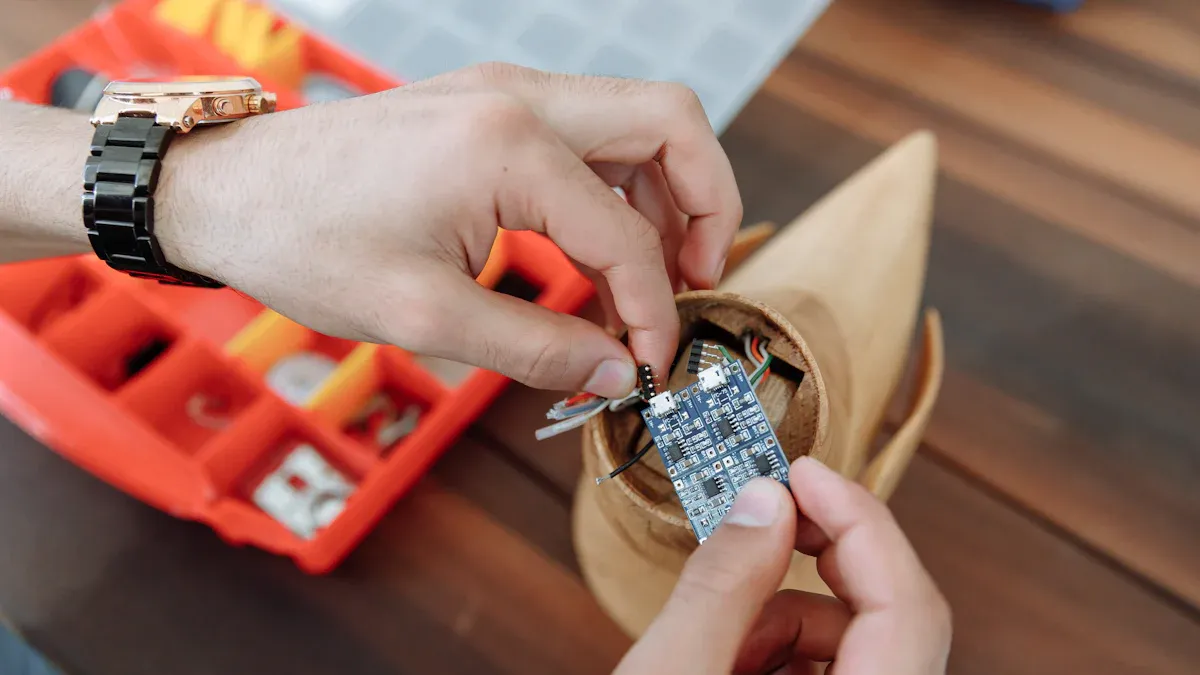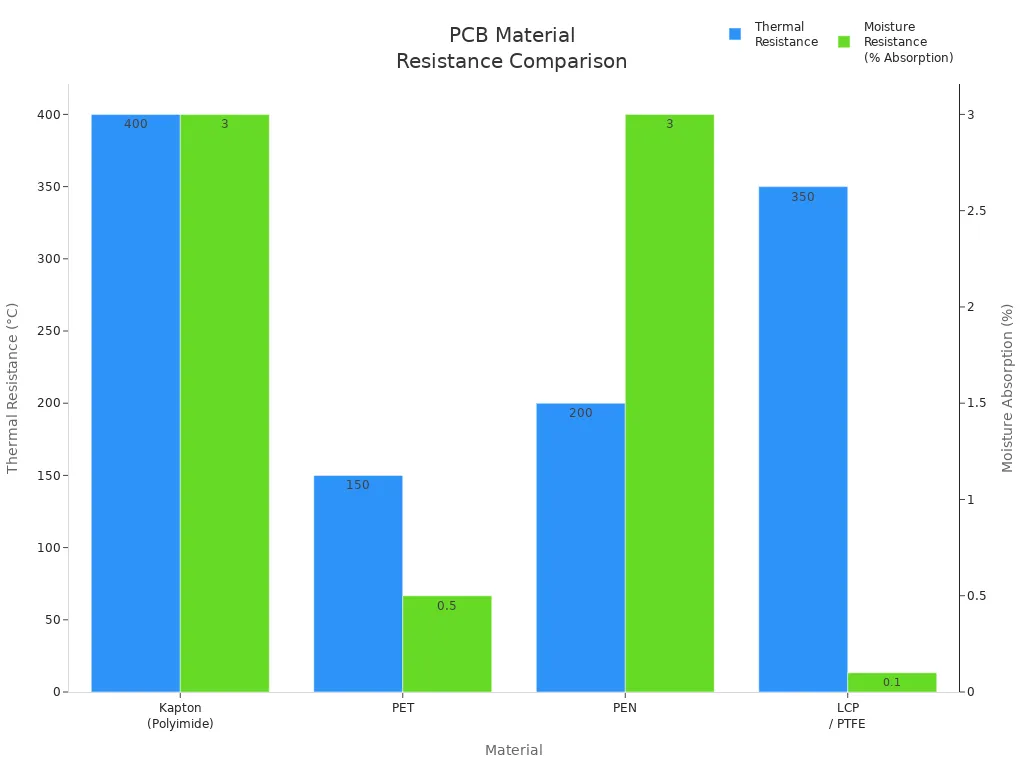Designers often pick a soft pcb for wearable devices. This is because it bends easily and feels better for users. Wearable technology needs to fit the body well. It should move with people every day and still work well. Recent surveys in the industry show some important things to think about when picking a PCB for wearables:
- Mechanical flexibility and durability help the device fit body shapes and handle bending.
- Thickness optimization affects how much the PCB can bend and how long it works.
- Electrical performance makes sure signals stay strong and clear.
- Material selection changes how flexible the PCB is and how well it handles heat or water.
- Manufacturing feasibility makes sure the design can be made without problems.
The best choice gives comfort to users, meets technical needs, and lasts a long time.
Key Takeaways
- Soft PCBs can bend and move easily. They fit the body well. This makes wearables more comfy and light to wear.
- Rigid PCBs are strong and usually cost less. But they cannot bend at all. They work best for bigger or stiff devices.
- Rigid-flex PCBs mix both types together. They give both strength and bending for better wearables.
- Picking the right PCB depends on what the device needs. You must think about bending, size, strength, and comfort.
- Good design and good materials help wearables last longer. They also make them feel nice to wear every day.
Overview
Soft PCB
Soft PCBs are important in wearable electronics. They are also called flexible PCBs. They use materials like polyimide and polyester. These materials let the circuit bend and twist. The circuit does not break when it bends. Polyimide is strong and handles heat well. That is why it is used most often. Polyester is flexible but does not like heat as much. A soft pcb has three main layers. There is a flexible core, an insulating layer, and a copper conductor. Adhesives like epoxy or acrylic hold these layers together. Coverlay films protect the circuit from water and chemicals. Special copper foils make the circuit tough for bending many times.
| Material/Layer | Function |
|---|---|
| Polyimide/Polyester | Flexible substrate, supports bending |
| Copper Foil | Conducts electricity, resists cracking |
| Adhesives | Bonds layers, adds strength |
| Coverlay Film | Protects from environment and wear |
Flexible double-sided PCBs are used a lot in wearables. They fit different shapes and can handle stress. Designers put these circuits in smartwatches, fitness bands, and medical sensors. They are thin and light, which makes them comfy. This also helps make small and easy-to-wear devices.
Rigid PCB
Rigid PCBs are made from hard materials like FR4 epoxy glass laminate. These boards do not bend at all. They keep their shape even when pushed or pulled. Rigid PCBs can have many layers. This lets them hold more parts and complex circuits. Microvias are tiny holes that link the layers. These holes help save space. They also help signals stay clear and strong.
- Rigid PCBs can have parts on both sides.
- They keep their size and shape very well.
- They are good for devices that do not need to bend.
| Aspect | Description |
|---|---|
| Materials | FR4, high-Tg laminates, polyimide-glass |
| Structure | Solid, stable, no flexibility |
| Component Mounting | Both sides possible |
Rigid PCBs are used in bigger or less flexible wearables. These devices do not need to bend.
Key Differences
PCB Flexibility
The biggest difference is flexibility. Flexible PCBs can bend and twist many times. They do not break when they move. Designers use rules for how much a PCB can bend. For moving parts, the bend should be 10 times thicker than the flex. For parts that do not move much, 6 times is enough. Rigid PCBs cannot bend at all. They do not have a bend radius. This is because they are not made to move. This is why flexible PCBs are better for wearables that move with the body.
Circuit Board Size and Weight
Wearable devices must be small and light. Flexible PCBs are better for this than rigid PCBs. The table below shows how they compare:
| Characteristic | Rigid PCBs | Flexible (Soft) PCBs |
|---|---|---|
| Thickness Range | 0.4mm to 6.0mm (commonly 1.6mm) | 0.1mm to 0.5mm (typically 0.2mm) |
| Weight | Heavier due to substrate | Approximately 75% lighter than rigid |
| Typical Applications | Computers, appliances, automotive ECUs | Medical devices, aerospace, wearables |
Flexible PCBs are much thinner and lighter. This makes them great for things you wear.
Printed Circuits Durability
How long a device lasts depends on how it is used. Rigid PCBs are strong and keep their shape. They are best for things that do not move a lot. Flexible PCBs can bend and twist over and over. They last longer in wearables that move a lot. But they can get damaged by sharp bends or rough use.
Circuit Board Comfort
Comfort is very important for wearables. Flexible PCBs fit the body’s curves. They help make thin and comfy designs. People often forget they are wearing these devices. Rigid PCBs are bigger and can feel uncomfortable, especially when moving.
Flexible PCBs let designers make wearables that feel natural and easy to wear.
Soft PCB in Wearables

Benefits
Soft PCBs give many good things to wearable devices. They help designers make products smaller and lighter. These circuits can bend to fit the body’s shape. This makes smartwatches and fitness trackers easy to wear for a long time.
- Soft PCBs let devices bend and twist without breaking. This makes them more comfortable and lets them move with you.
- They use tough materials like polyimide. These materials stand up to sweat, heat, and tough places. Devices last longer and work well every day.
- Flexible PCBs mean fewer connectors inside a device. Fewer connectors mean fewer things can go wrong. This makes the device work better, even when it bends or shakes.
- Soft PCBs help make devices smaller. Designers can add more features in less space. This means wearables can be tiny and still do a lot.
- Many tests, like heating and shaking, show soft PCBs work well in real life.
Soft PCBs also let engineers try new ideas. They can make devices that wrap around your wrist or stick to your skin. Medical wearables use these circuits to check your heart, track movement, or measure temperature. Patients like these devices because they feel normal and do not bother them.
Soft PCBs help make wearable technology that is comfy, small, and works well.
Drawbacks
Even though soft PCBs are great, they have some problems. Making a soft PCB costs more than making a rigid one. Special materials and careful work make the price go up. This can make the final product cost more.
Soft PCBs can break more easily. Sharp bends or rough use can hurt the circuit. Designers must plan to keep stress away from weak spots. Fixing them is hard because they are thin and bendy.
- Higher costs because of special materials and steps
- More chance of damage from bending or rough use
- Harder to design and put together
- Not good for devices that need to hold heavy parts
Rigid PCB in Wearables

Benefits
Rigid PCBs have many good points for wearable devices. Companies pick them because they cost less to make. The way rigid PCBs are made uses fewer connectors. The steps to put them together are simple. This helps lower the price of each device. Companies also save money because it takes less time and work to build them. These PCBs do not break often, so fixing them does not cost much.
Another big plus is how tough they are. Rigid PCBs use strong materials that last a long time. These materials do not rust or wear out fast. Devices with rigid PCBs can take hits and shakes. This means they work well if dropped or bumped. Careful building helps these PCBs last for years, even with daily use.
The table below shows the main good points:
| Benefit Category | Description |
|---|---|
| Cost-effectiveness | Uses fewer connectors and easy steps. Saves money and needs less fixing. |
| Durability | Stands up to shock, shaking, rust, and getting old. Makes devices last longer. |
Rigid PCBs are best for bigger wearable devices. Things like smart glasses and medical monitors use them a lot. These devices do not need to bend or twist. The hard board holds heavy parts and tricky circuits.
Rigid PCBs give designers a strong base for wearables that last a long time.
Drawbacks
Even though rigid PCBs are strong, they have some problems. The biggest problem is they cannot bend or twist. This makes them hard to use in things that must fit close to the body. They do not work well in fitness bands or smart patches that need to be flexible.
Rigid PCBs also make devices heavier and thicker. Wearables with rigid PCBs can feel big or strange, especially when moving. The hard board can make it hard to design small or comfy shapes.
- Cannot bend for curved or moving designs
- Heavier and thicker than soft PCBs
- Not as comfy for wearables that hug the body
- Harder to make small or new shapes
Most rigid PCB wearables are for things that do not move much. Bigger devices that stay in one spot use rigid PCBs for their strength. But for new wearables that need to be comfy and flexible, rigid PCBs may not be the best choice.
Designers have to think about saving money and making things last, but also about comfort and flexibility for new wearables.
Rigid-Flex and Next-Gen Options
Rigid-Flex PCB
Rigid-flex PCBs mix the good parts of rigid and flexible boards. Designers use these boards to make wearables smaller and lighter. They also help make devices more comfy to wear. The rigid parts hold heavy or delicate pieces in place. The flexible parts let the board bend and twist. This helps the device fit the shape of your body.
- Rigid-flex PCBs are strong like rigid boards but can also bend.
- The flexible parts help the device move and fit better on you.
- There are fewer connectors and solder joints. This means there are fewer things that can break. Devices work better when you move or sweat.
- Multi-layer designs make the PCB up to 35% smaller. This helps make fitness trackers and smartwatches tiny.
- Special materials like polyimide and polyester make the board tough and bendy. Coatings keep water and dust away from the board.
Rigid-flex PCBs help engineers make wearables that are strong, work well, and feel good to wear every day.
Stretchable PCB
Stretchable PCBs are a new step for wearable tech. These boards can stretch, twist, and bend in many ways. Engineers use silicone rubber and liquid metal to build these circuits. The circuits do not break when pulled or pressed.
Stretchable PCBs help make new kinds of wearables. Smart patches, electronic skin, and health monitors use these boards. They stay close to your body. Liquid metal PCBs can stretch and go back to their old shape. This is good for devices that move with your skin.
- Stretchable PCBs fit close to your skin and feel comfy.
- They can be stretched and bent many times.
- Liquid metal circuits are very bendy and work well.
New PCBs will help make wearables that feel like part of your skin and do things never done before.
Design Considerations
Miniaturization
Engineers have a hard job making wearables smaller. They need to fit tiny parts, like tantalum capacitors, into small spaces. These parts must be put in the right spot. The soldering heat must be just right. If it gets too hot, the parts might break. Wearable devices move a lot, so the PCB must handle lots of bending and stress. Designers often hide resistors and capacitors inside the PCB layers. This saves up to half the space on top. It also helps keep signals strong. But hiding parts makes the design harder to change later. Testing is also tougher because the parts are not easy to see.
- Tiny parts need careful placement.
- Hidden passives save space but make design harder.
- Movement means strong attachment is needed.
Ergonomics
Wearable devices must feel good on your body. Designers use soft pcb materials so circuits can bend and twist. This lets the device fit the shape of your wrist or arm. Fewer connectors and cables make the device lighter and less bulky. When the PCB matches your body, you can wear it longer without pain. Good design also stops motion artifacts. These can mess up sensor readings when you move.
A wearable that fits well feels like part of your daily life.
Environmental Resistance
Wearable devices face sweat, water, heat, and chemicals every day. The PCB material you pick changes how well the device lasts. Polyimide (Kapton) is great at handling heat and chemicals. This makes it good for medical and fitness wearables. PET and PEN cost less but do not last as long. LCP and PTFE are best for keeping out water in special uses. The table below shows how these materials compare:
| Property / Material | Kapton (Polyimide) | PET | PEN | LCP / PTFE |
|---|---|---|---|---|
| Thermal Resistance | Up to 400°C | ~150°C | Up to 200°C | High |
| Chemical Resistance | High | Low | Moderate | High |
| Moisture Resistance | Moderate | Better | Moderate | Superior |
| Flexibility & Durability | Excellent | Good | Good | Limited |
| Cost | High | Low | Moderate | High |
| Typical Applications | Medical, aerospace | Disposable | Displays | High-frequency |

Reliability
Reliability is very important for wearables. Soft pcb designs remove extra connectors and cables. This lowers the chance of things breaking. Flexible materials let the circuit bend without snapping, even during hard activity. Rigid-flex PCBs mix strong and bendy parts. This makes the device tougher. To stop problems, engineers follow bending rules. They pick materials that handle heat the same way. They use coverlays to protect the circuit. Careful trace routing and working with certified makers help the device last longer.
- Flexible PCBs handle movement and shaking.
- Good design and materials stop cracks and peeling.
- Certified making and testing make devices work better.
Choosing the Right PCB
Application Needs
To pick the best PCB, you must know what the device does. Engineers think about how people will wear the device and where it will go. They also look at what the device needs to do and what it will go through. Some devices need to bend or twist. Others need to hold heavy parts or have tricky circuits.
- Flex PCBs are good for thin and bendy designs. These boards fit into small or curved spaces. That is why they work well in fitness trackers and smartwatches.
- Devices that move or shake a lot need to be strong. Flex PCBs can handle bending and shaking better than rigid ones.
- Wearables should not be heavy. Lighter PCBs make them more comfy and easier to wear.
- The materials used, like polyimide films and special glue, must handle heat, stress, and chemicals.
- Making the board with careful steps, like fine etching and stacking layers, helps it meet high standards.
- Tough tests, like bending and heating, show if the board will last when used every day.
- Rigid PCBs are best when the device does not need to bend. These boards cost less and are easier to make.
Engineers also think about the antenna. PCB antennas, like loop or patch types, can be put right on the board. This saves space and helps make the device smaller. The best antenna depends on how big it is, what signals it uses, and how much power it needs.
User Experience
How the device feels is very important. People want to wear it all day without problems. Flexible PCBs help make shapes that fit the body better. This stops sore spots and makes the device more comfy.
- Lighter and thinner boards make the device easy to wear.
- Flexible circuits let designers make cool and comfy shapes.
- Fewer connectors and wires mean fewer things can break. The device also looks smoother.
- Antennas built into the board make the device smaller and work better.
Picking the right PCB helps make a wearable that people like. Comfort, strength, and how well it works all depend on choosing the best PCB for the job.
Picking the best PCB for wearables means thinking about both how it works and how it feels to wear. Soft and rigid-flex PCBs can bend and fit around curves. These are good for flexible designs. Rigid PCBs are strong and work well for devices that do not move much. Designers should remember some important tips:
| Key Design Tip | Recommendation |
|---|---|
| Material Selection | Pick polyimide for bending and handling heat |
| Bend Radius | Use 6 times the thickness for still parts, 10 times for moving parts |
| User Comfort | Pick thin and skin-friendly materials |
| Manufacturing Collaboration | Talk with makers early in the process |
Mixing different PCB types and using more machines will change how wearables are made in the future.
FAQ
What makes soft PCBs better for wearable devices?
Soft PCBs can bend and twist with your body. They help make wearables that feel light and comfy. These boards fit on curved places and let designers try new shapes.
Can rigid PCBs be used in any wearable device?
Rigid PCBs are best for bigger or stiff wearables. They hold heavy parts and tricky circuits. Designers pick them when the device does not need to bend.
Are soft PCBs more expensive than rigid PCBs?
Yes, soft PCBs usually cost more money. They use special materials and need careful work. But they give better comfort and can bend for many wearable designs.
How do rigid-flex PCBs improve wearable technology?
Rigid-flex PCBs mix strong and bendy parts together. This saves space and lowers the chance of breaking. Devices get smaller, work better, and are easier to wear.
What materials are common in soft PCBs for wearables?
| Material | Key Feature |
|---|---|
| Polyimide | Handles heat very well |
| Polyester | Bends easily |
| Copper Foil | Moves electricity well |
These materials help soft PCBs last longer and work well every day.










 2025-07-15
2025-07-15
 BEST
BEST

.png)
.png)
.png)
.png)

.png)

